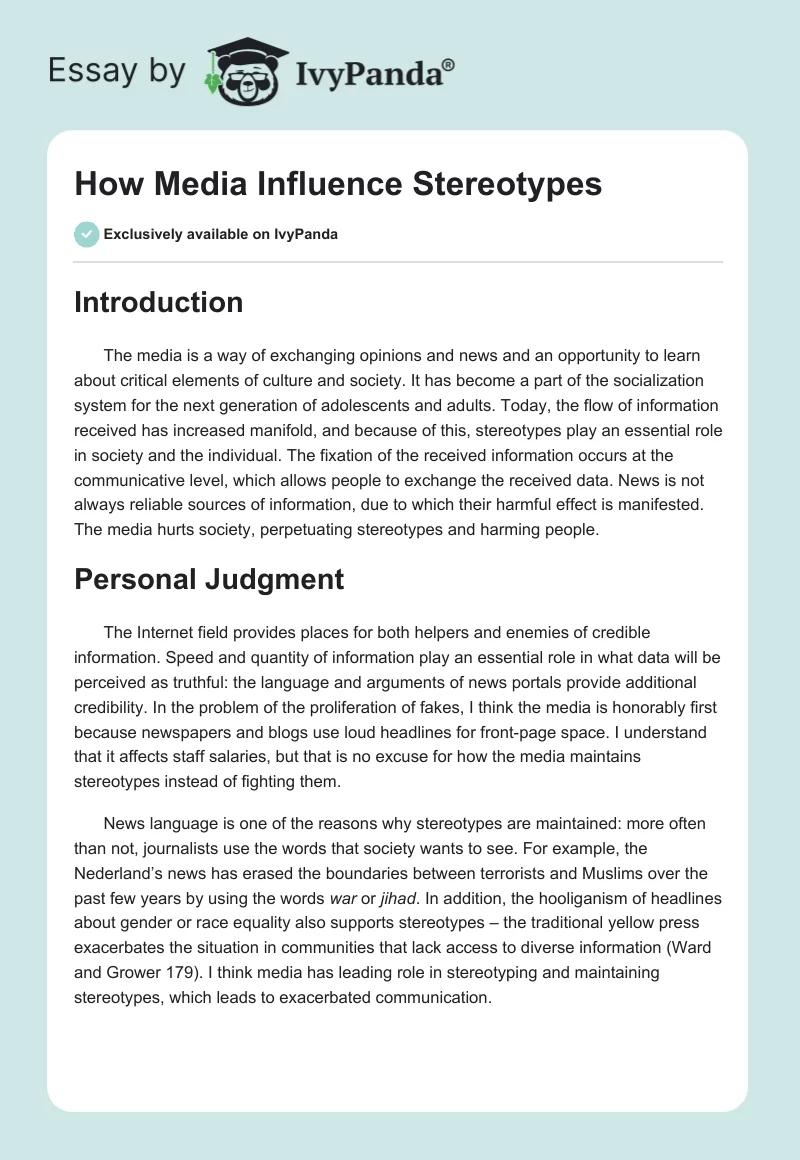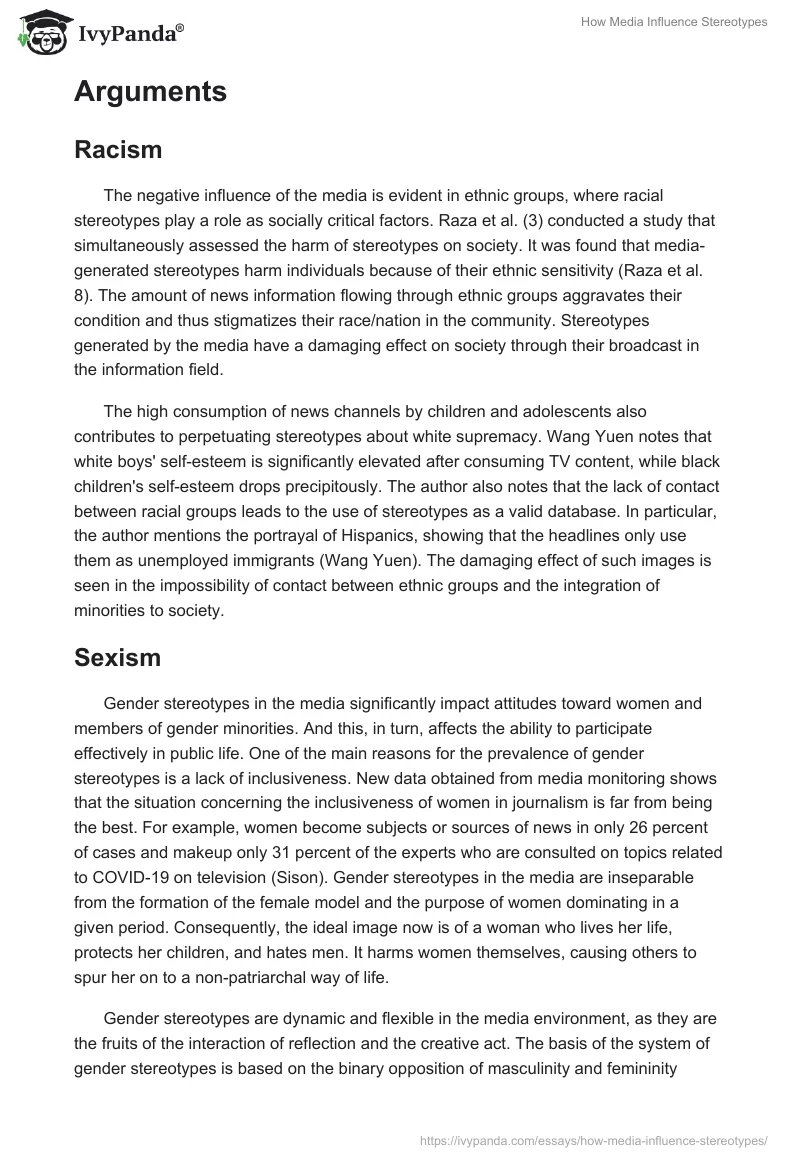Introduction
The media is a way of exchanging opinions and news and an opportunity to learn about critical elements of culture and society. It has become a part of the socialization system for the next generation of adolescents and adults. Today, the flow of information received has increased manifold, and because of this, stereotypes play an essential role in society and the individual. The fixation of the received information occurs at the communicative level, which allows people to exchange the received data. News is not always reliable sources of information, due to which their harmful effect is manifested. The media hurts society, perpetuating stereotypes and harming people.
Personal Judgment
The Internet field provides places for both helpers and enemies of credible information. Speed and quantity of information play an essential role in what data will be perceived as truthful: the language and arguments of news portals provide additional credibility. In the problem of the proliferation of fakes, I think the media is honorably first because newspapers and blogs use loud headlines for front-page space. I understand that it affects staff salaries, but that is no excuse for how the media maintains stereotypes instead of fighting them.
News language is one of the reasons why stereotypes are maintained: more often than not, journalists use the words that society wants to see. For example, the Nederland’s news has erased the boundaries between terrorists and Muslims over the past few years by using the words war or jihad. In addition, the hooliganism of headlines about gender or race equality also supports stereotypes – the traditional yellow press exacerbates the situation in communities that lack access to diverse information (Ward and Grower 179). I think media has leading role in stereotyping and maintaining stereotypes, which leads to exacerbated communication.
Arguments
Racism
The negative influence of the media is evident in ethnic groups, where racial stereotypes play a role as socially critical factors. Raza et al. (3) conducted a study that simultaneously assessed the harm of stereotypes on society. It was found that media-generated stereotypes harm individuals because of their ethnic sensitivity (Raza et al. 8). The amount of news information flowing through ethnic groups aggravates their condition and thus stigmatizes their race/nation in the community. Stereotypes generated by the media have a damaging effect on society through their broadcast in the information field.
The high consumption of news channels by children and adolescents also contributes to perpetuating stereotypes about white supremacy. Wang Yuen notes that white boys’ self-esteem is significantly elevated after consuming TV content, while black children’s self-esteem drops precipitously. The author also notes that the lack of contact between racial groups leads to the use of stereotypes as a valid database. In particular, the author mentions the portrayal of Hispanics, showing that the headlines only use them as unemployed immigrants (Wang Yuen). The damaging effect of such images is seen in the impossibility of contact between ethnic groups and the integration of minorities to society.
Sexism
Gender stereotypes in the media significantly impact attitudes toward women and members of gender minorities. And this, in turn, affects the ability to participate effectively in public life. One of the main reasons for the prevalence of gender stereotypes is a lack of inclusiveness. New data obtained from media monitoring shows that the situation concerning the inclusiveness of women in journalism is far from being the best. For example, women become subjects or sources of news in only 26 percent of cases and makeup only 31 percent of the experts who are consulted on topics related to COVID-19 on television (Sison). Gender stereotypes in the media are inseparable from the formation of the female model and the purpose of women dominating in a given period. Consequently, the ideal image now is of a woman who lives her life, protects her children, and hates men. It harms women themselves, causing others to spur her on to a non-patriarchal way of life.
Gender stereotypes are dynamic and flexible in the media environment, as they are the fruits of the interaction of reflection and the creative act. The basis of the system of gender stereotypes is based on the binary opposition of masculinity and femininity (Ward and Grower 181). While masculinity is equated with a cultural, active-creative, civilized beginning, femininity is correlated with a natural, passive-reproductive one. In this regard, social roles are allocated, attributed, and highlighted in journalistic materials.
Mental Health
A significant role in the stereotyping of mental health disorders is assigned by the media, which creates misleading information about the behavior of people with mental illnesses. They can form and spread stereotypes about certain mental disorders, unjustifiably pointing them out in their materials. In addition, journalists often use hate speech, even if they do not aim to humiliate or insult an entire group of people (Srivastava et al.). It may be noted that portraying minorities in a positive light can lead to a counter-strategy of their representation, as it indirectly contributes to the risk of new harmful and discriminatory images. This is due to the desire to integrate social groups and minorities into the cultural mainstream by leveling their differences. It can lead to the assimilation of the dominant group’s norms and values by minorities while denying their individuality.
The stereotypes of people’s behavior formed by the news cause society to stop recognizing actual manifestations of mental illness. It has been noted that the lack of real surveillance leads to stigma and un-education (Srivastava et al.). Authors continue the thought by stating that the distortion in television has a detrimental effect on children and adolescents, who will stop seeking help because the news is telling unpleasant things about them. Presenting facts with emotional impact harms people with mental disorders, reinforcing the uneducated nature of society on this issue.
The Counterargument and its Refutation
The negative influence of the media is disputed because positive effects of news do exist. Wille et al. argue that television programs have no impact on girls’ motivational inclinations and performance in mathematics, despite stereotypes. The authors question the stereotype threat by pointing out no meaningful differences in children’s attitudes and abilities. However, such an argument is not entirely accurate because the study’s authors overlook the long-term effects.
There are limitations to the study that indicates the results are incomplete: The sample is from an American society in which equity programs are integrated into learning. This influences and skews the study results: children who receive media education and equality materials will be less likely to be influenced by stereotypes (Ward and Grower 184). However, this does not mean that the ethnic groups of boys and girls are the same and other adolescents are not stereotyped.
Conclusion
Thus, the media harms society by making and maintaining stereotypes. More stereotypes are held based on race and gender; coverage of mental illness is also poorly focused on equality and respect. Research proves that a high degree of stereotyping is due to a lack of education. Although the authors found no correlation between stereotypes and children’s abilities, the limitations of their research call into question the positive role of media and other television programs.
Works Cited
Raza, Syed Hassan, et al. “Examining the Effects of Media-Generated Stereotypes on Receivers’ Trust and Attitude in Pakistan.” Moderating Influence of Ethnicity and Gender. Information, vol. 13, 2021. doi:10.3390/info12010035.
Sison, Tessa. “Canada: Just 31% Of News Subjects Are Women.”Who Makes the News? 2022.
Srivastava, Kalpana et al. “Media and Mental Health.” Industrial Psychiatry Journal, vol. 27, no. 1, 2018, pp. 1-5. doi:10.4103/ipj.ipj_73_18
Wang Yuen, Nancy. “How Racial Stereotypes In Popular Media Affect People — And What Hollywood Can Do To Become More Inclusive.”Scholars, 2019.
Ward, Monique L., and Grower, Petal. “Media and the Development of Gender Role Stereotypes.” Annual Review of Developmental Psychology, vol. 2, 2020, pp. 177-199. doi:10.1146/annurev-devpsych-051120-010630.
Wille, Eike, et al. “Gender Stereotypes in a Children’s Television Program: Effects on Girls’ and Boys’ Stereotype Endorsement, Math Performance, Motivational Dispositions, and Attitudes.” Frontiers in Psychology, 2018. doi:10.3389/fpsyg.2018.02435.


